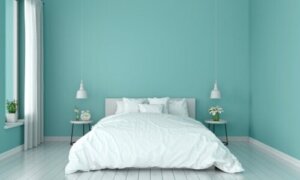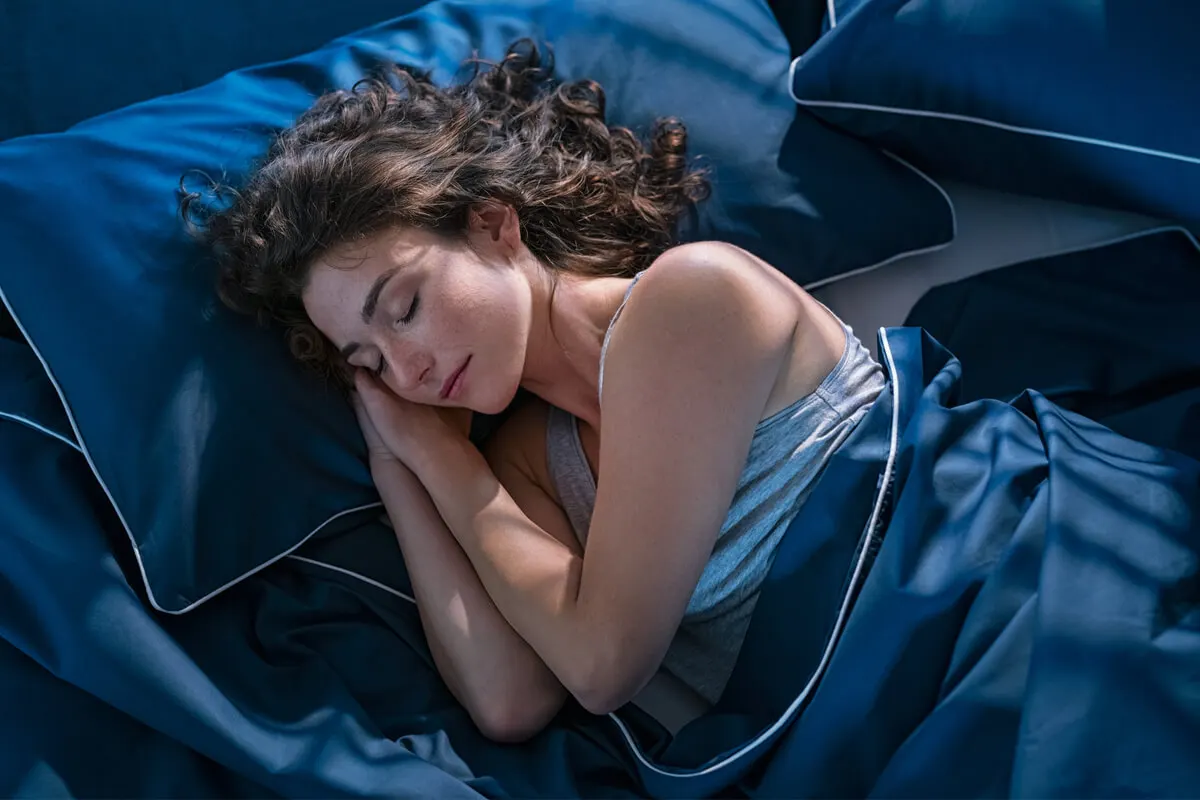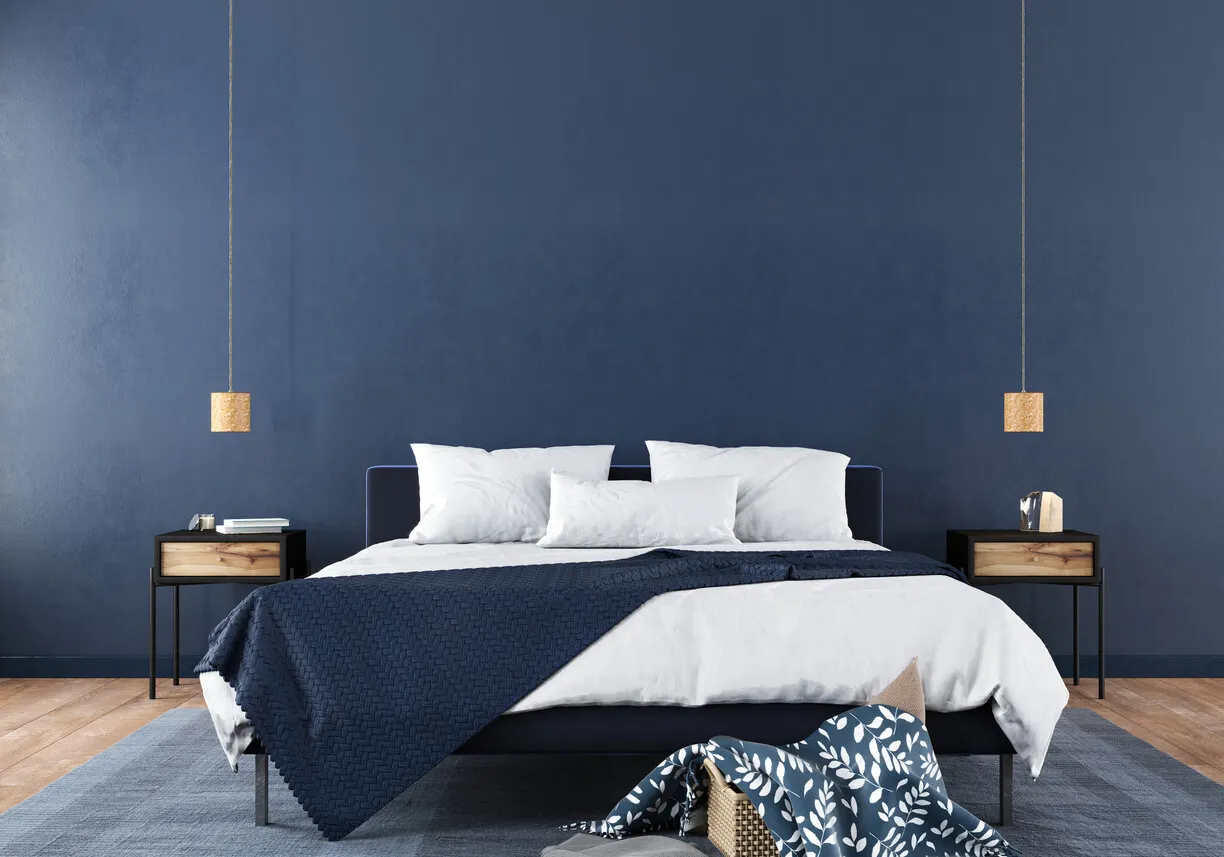8 Relaxing Colors for the Bedroom


Reviewed and approved by the psychologist Elena Sanz
A pleasant night’s sleep is key for optimal performance. For this reason, proper rest needs allies such as a good mattress, the ideal temperature, and relaxing colors for the bedroom.
If the mattress is old or deteriorated, then it makes us uncomfortable. In rooms where it’s too cold or too hot, it’s difficult to get a good night’s sleep. On the other hand, walls painted in strident tones don’t contribute to a good night’s sleep.
On the other hand, soft tones make up a space in which it is pleasant to relax. This is because color influences our mood, behavior, and sleep. That’s what we’d like to focus on in today’s article.
We think you may also enjoy reading this article: 5 Ideas for a More Welcoming and Relaxing Bedroom
Colors and their influence on our mood
The subconscious assimilates a meaning for each color. This is how they help to achieve calm in stressful situations or even encourage sadness.
According to a publication of the Tecnológico de Monterrey, it’s been proven that colors affect our emotional, psychological, and physical states. In turn, tones play with our perception and directly or indirectly influence mood.
The importance of selecting relaxing colors for the bedroom
A study published by the Vic School of Art states that color stimulates or represses, cheers, or saddens and also has the power to awaken passive or active attitudes. The text adds that colors favor warm sensations and can convey the impression of order or disorder.
These characteristics are closely related to what’s expected of a bedroom environment. These rooms require a pleasant atmosphere to make the most out of the hours of sleep.
The Journal of Physiological Anthropology and Applied Human Sciences reports that light sources with higher color temperatures affect the quality of our sleep. Also, as the National Institutes of Health (NIH) explains, sleep maintains the body’s energy balance, intellectual function, alertness, and mood.

Take note of the best relaxing colors for the bedroom
After understanding that getting enough rest keeps people healthy, it’s wise to adjust the environment so that rest actually restores. Bedrooms are sanctuaries that demand tranquility. In addition to sleeping, you can exercise, meditate, or do yoga in them.
Whatever the practice, the effects are enhanced if the room has colors that are conducive to relaxation.
1. White
White symbolizes peace. It’s a color that favors illumination, is linked to neatness, and promotes serenity, which is essential to fall asleep at night and relaxing during the day.
Pure white is the lightest color of the spectrum, but it has many variations:
- Chalk
- Oyster
- Pearl
- Ivory
- Bone
- Cream
2. Beige
Light or neutral beige decorations bring more warmth than white. It’s also a serene color that’s appropriate for both adult and children’s rooms. The understated nature of this shade lends itself to playing with bold furnishings, perhaps in deeper beige or soft yellows.
3. Pink
The variety of pink is summed up as balanced and cozy. The pastel or “pale pink” range conveys relaxation and sweetness. Pink environments are ideal for taking a break from the hustle and bustle of everyday life.
This color is usually mixed with other colors, such as white and gray, to reduce saturation and increase a sensation of relaxation. Accessories or furnishings in such pigments can also work to complement the bedroom style.
4. Blue
Blue is a color related to calm energy. Above all, the light range conveys calm and evokes the sea and the sky. This tone promotes concentration, security, and serenity.
It’s believed that shades of blue minimize tensions and the feeling of fear. The color is among the most relaxing to sleep with, even in strong shades.
5. Soft yellow
Yellow is a positive color of light and joy; these are characteristics that don’t detract from its relaxing qualities. Whenever you opt for the soft range of this palette, you will feel as sense of tranquility in your bedroom because light yellow are shades that allude to the sun’s rays within a quiet space.
6. Green
Green is the color of vitality and one of the most beneficial colors for healthy rest. It’s linked to nature, hope, and life. If there’s a shade that provides freshness, it’s green.
Pigments in this range relax the eye, amplify feelings of security, and are pleasing to both the mind and body. Less bright palettes also help us to rest better due to the fact that they activate a stillness effect.
7. Gray
Gray tones are associated with simplicity. Decorative trends tend to include them in their palettes because it is a color with relaxing qualities, especially for adult rooms.
Gray is neutral, modern, and elegant. Light grey, with a tendency to be silver or more intense, is a pigment that provides a feeling of spaciousness and comfort.
Like this article? You may also like to read: 8 Failsafe Ideas to Decorate Your Home with Mustard Color
8. Lilac
Lilac palettes are all about calmness and poise. Like violet and light purples, lilac is synonymous with luxury; this color is also often linked with spirituality and wisdom.
This color is attributed to calming, creativity-stimulating, and sleep-promoting properties. Since it’s a pigment with a higher proportion of cold tones, it’s believed to have calming effects.
Architectural Digest magazine validates the fact that cold colors like blue and green have meditative and relaxing reactions in the mind, which is perfect to relieve stress and anxiety.

The advantages of combining relaxing colors for the bedroom
There’s no rule restricting bedrooms to a single color for relaxation. There are countless designs and contrasts according to purpose and individual taste.
A popular alternative is to combine white tones with wood, taking advantage of furniture, flooring, and decorative elements. Since wood is a natural material, wood stains are comfortable and provide a special attraction.
Mauve tones go very well with vanilla and cream colors, pink is a good match with beige and white, while greens transmit calm when fused with white, blue, or earth pigments.
How to choose the best relaxing colors for your bedroom?
Color theory is very helpful mixing tones. Likewise, it’s important to bear in mind that fewer colors are better because they simplify order and visual harmony.
Prioritizing your personal tastes and opting for shades that make you feel calm and lift your spirits are key tips to have relaxing colors in the bedroom. So, which colors will you choose?
All cited sources were thoroughly reviewed by our team to ensure their quality, reliability, currency, and validity. The bibliography of this article was considered reliable and of academic or scientific accuracy.
- Fernández P. Un mundo de colores, ¿realmente influyen en el estado de ánimo? Tecnológico de Monterrey. México; 2022. https://conecta.tec.mx/es/noticias/zacatecas/educacion/un-mundo-de-colores-realmente-influyen-en-el-estado-de-animo
- Ishibashi K, Higashihara Y, Kitamura S, Kozaki T, Noguchi H, Yasukouchi A. Efecto de la temperatura de color de las fuentes de luz en el sueño de onda lenta. Revista de Antropología Fisiológica y Ciencias Humanas Aplicadas. Vol. 24. Núm. 2 pp. 183-186. Japón; 2005. https://www.jstage.jst.go.jp/article/jpa/24/2/24_2_183/_article/-char/ja/
- Khana Tyagi P. Los expertos hablan: ¿Cuáles son los colores más relajantes para pintar tu casa? Architectural Digest. España; 2021. https://www.revistaad.es/decoracion/articulos/expertos-hablan-cuales-son-colores-relajantes-para-pintar-casa/28434
- Los beneficios de dormir. Institutos Nacionales de Salud. Estados Unidos; 2013. https://salud.nih.gov/articulo/los-beneficios-de-dormir/
- Psicología del color. Escuela de Arte de Vic. España. https://perio.unlp.edu.ar/catedras/iddi/wp-content/uploads/sites/125/2020/04/Psicologia-del-color.pdf
- Teoría del color. Goodwill Community Foundation, Inc. https://edu.gcfglobal.org/es/conceptos-basicos-de-diseno-grafico/teoria-del-color/1/
This text is provided for informational purposes only and does not replace consultation with a professional. If in doubt, consult your specialist.








